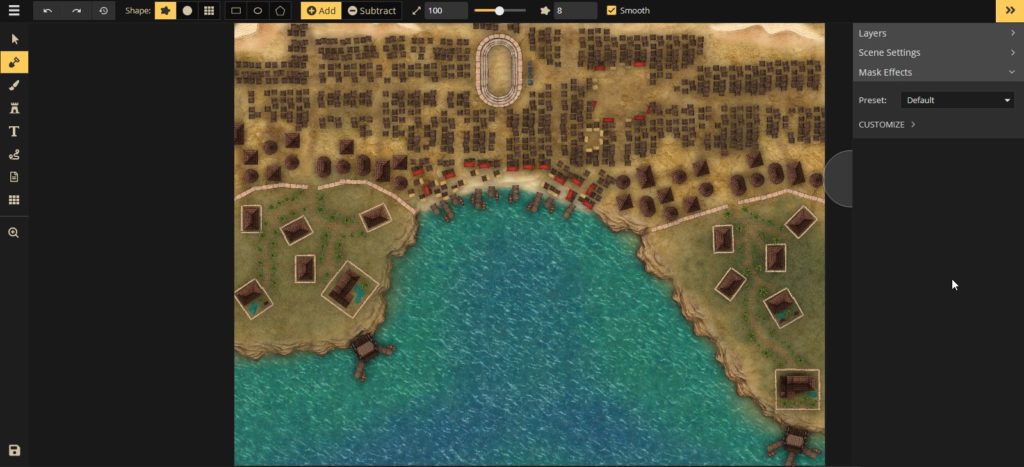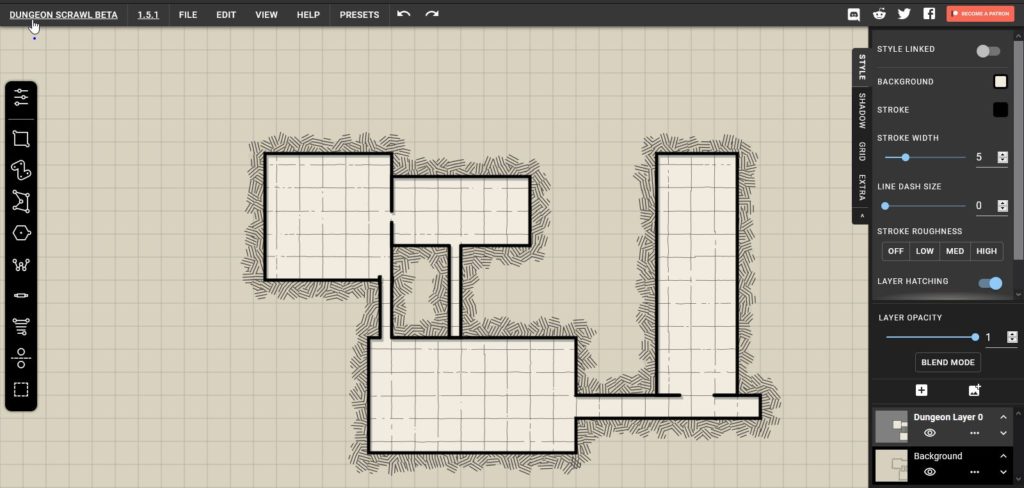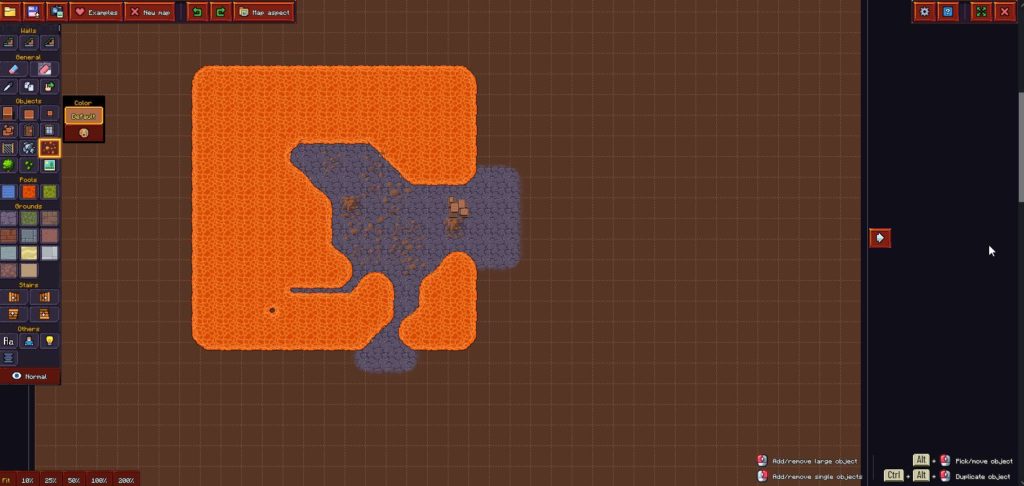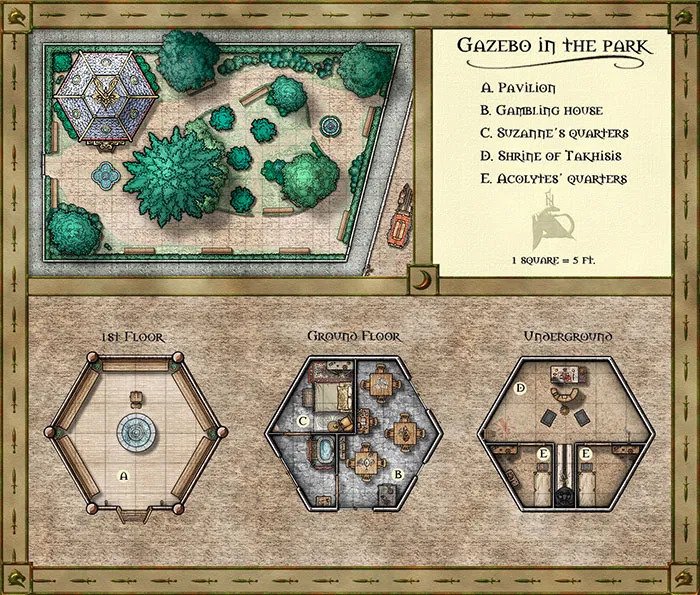Commercial Use Dungeon Design Tools
Are you looking for the best solution to create DnD maps? Look no further! In this article, we cover the best DnD map makers and their pros, cons, and use cases.
The two types of D&D maps
Because it is a tabletop game, most of the visualization in D&D is left up to the imagination. Some groups may rely on the DM's descriptions of the locations they find themselves in, while other groups use maps. Whether you play in-person or online and with or without battlemaps, chances are you will be creating a map for something while playing D&D.
There are two main types of maps used commonly in D&D: regional maps and battlemaps.
Regional Maps
These maps are typically on a larger scale than battlemaps. They show the region from a bird's-eye view. These maps can be anything from a world map, provincial map, or city map.
If used for exploration, then these maps can contain a grid. This type of exploration is typically called a "hex crawl" and is addressed in depth in the D&D Adventure Tomb of Annihilation.
Battlemaps
These maps are usually on a smaller scale than regional maps. Typically, they are self-contained for a single encounter, though they can grow to display the entirety of a dungeon or building that players are working their way through.
Battlemaps are usually overlaid by a standard 5-foot by 5-foot grid to make player movement and scaling consistent.
How to make D&D maps
There are two primary ways to make maps; they can be hand-drawn or made using online software. Hand-drawn maps have been around since the inception of D&D. These maps, most commonly used for in-person games, can be combined with terrain pieces or miniatures.
Hand-drawn maps can be drawn on anything from a piece of printer paper to whiteboards, but in recent years, wet-erase grid maps have become thecrème de la crème solution.
Mapmaking software, due to the sheer number of options, is a much less straightforward solution. In this article, we will explore which software is best for which purposes while making D&D maps.
The Best DnD Map Making Software
There will never be a straight-up "best" D&D map maker. The below-featured map makers will list the pros and cons of each software, as well as their best use case.
Inkarnate
Inkarnate is easily the best fantasy map making software on the market. It's got a slick UI, tons of assets, and can create detailed maps in a matter of minutes.

Pros
- Easily the most fleshed out, versatile map building option
- Completely online, no software download or install
- UI is thorough enough to create amazing maps but streamlined enough to build maps quickly
- Free and Pro versions
- Can import custom assets
- Pro version allows for commercial sale of maps
Cons
- Walls don't "snap" together, which can make the creation of dungeons or other indoors areas clunky
- Subscription model, not a one time purchase
- UI can get slow on big maps with lots of assets or slow internet connection
Use Case
Inkarnate can be used to create regional maps and battlemaps. I have found myself reaching for Inkarnate most of the time I am creating a straightforward battlemap. Because I try to keep my session prep to under two hours, it's extremely nice to be able to punch out a detailed map in five to ten minutes.
Inkarnate's regional map maker is also a great tool, though I tend to use it much less often.
I do have to say that creating a map with lots of rooms, such as a dungeon or large building, is a bit of a grind with Inkarnate simply due to the level of detail they require.
All in all, I would compare Inkarnate to a "map-focused Photoshop". The layering, blending, and usage of assets has a similar feel to the infamous image editing software and while it might not be the most streamlined D&D map-making software, it is a great mix of easy to use and customizable.
Check out the free or pro version at inkarnate.com
Wonderdraft
Wonderdraft is a fantasy map-making software that focuses specifically on regional maps.

Pros
- Regional map-making tools are unrivaled
- One time purchase
Cons
- Software download, no in-browser option
- While battlemaps can be created using the software, it is certainly not meant for this application
- No free option
Use Case
Wonderdraft is unrivaled in its ability to create regional maps. While Inkarnate is a close second, the one time purchase, huge array of assets, and streamlined UI make this the best solution for larger-scale maps.
Buy Wonderdraft for $29.99 at wonderdraft.net
Dungeondraft
From the same creator as Wonderdraft, Dungeondraft focuses specifically on smaller-scale battlemaps.

Pros
- The vector-based system can scale to any resolution
- Walls and floors are seamlessly integrated, making the creation of complex indoor environments a breeze
- Custom assets, brushes, etc. are easily available
- No internet required to use
- Built-in lighting system
- One time purchase
- No additional commercial licensing
Cons
- Software download, no in-browser option
- While regional maps can be created using the software, it is certainly not meant for this application
- No free option
- From personal experience, can crash unexpectedly on the M1 Macbook Air
- Fewer assets than Inkarnate
Use Case
Dungeondraft has been my go-to battlemap creator recently, especially when doing an interior scene such as a dungeon, cave, or fortress. In my opinion, Dungeondraft's Building Tool is the quickest and most effective way to create indoor battlemaps out of any D&D map-making software available on the market.
Buy Dungeondraft for $29.99 at https://dungeondraft.net/
Dungeon Scrawl
Dungeon Scrawl is an online map builder designed to create simple maps with a hand-drawn feel.

Pros
- Import from donjon Random Dungeon generator
- The UI is very clean and easy to use
- The simplified purpose of the tool allows the creation of complex buildings or intricate tunnels very quickly
- Free to use
- Tons of unlimited pixel exportable options that can integrate with Photoshop or Illustrator to further populate maps
- Assets by Two Minute Tabletop (for non-commercial use only)
Cons
- Maps cannot mimic real-world textures like Inkarnate or Dungeon Fog
- Battlemaps only, no regional map options
Use Case
Dungeon Scrawl is meant to do one thing really well, create intricate dungeons. Whether you are creating a large building with multiple rooms and floors, or a cavern that twists and turns under the ground, Dungeon Scrawl is the best option to create them quickly and effectively.
If you would like your dungeon to be populated with intricate features, Inkarnate is a better bet but it will take much longer to produce a quality result.
You can check out Dungeon Scrawl for free at probabletrain.itch.io/dungeon-scrawl. If you like it, please support the developers 🙂
Dungeon Fog
Dungeon Fog is similar to Inkarnate. It is an online builder that has tons of assets and textures with a freemium model.

Pros
- Can organize maps into groups or "floors" as well as into campaigns
- Door and windows snap to walls allowing for easier creation of multiple rooms
- Better organization of assets than Inkarnate
- Can be used to make regional maps and battlemaps
Cons
- Much more expensive than Inkarnate
- Less free assets than Inkarnate
- UI isn't very easy to navigate
- Very hard to find which assets can be used for free users
Use Case
Dungeon Fog is a competitor with Inkarnate, but in my opinion, it is more expensive with a less user-friendly interface and limited functionality.
The biggest advantage Dungeon Fog has over Inkarnate is the ability to quickly make dungeons or large buildings with interconnecting rooms.
For a full review of the software check out our Dungeon Fog Review. You can check out Dungeon Fog at dungeonfog.com and get 10% off using the coupon code ARCANEEYE.
Dungeon Builder by Hobbyte
Hobbyte is a downloadable map builder that focuses on isometric (3D) dungeons.

Pros
- Extremely unique and cool way of displaying maps
- Commercial options available
- Can make small regional maps and dungeon maps
- Easy to mod assets
- You can roll dice, open doors, reveal traps, and gradually present your maps manually or using their fog of war feature. This is important because these maps would be extremely difficult to use in a typical online platform like Roll20 and Fantasy Grounds.
- Scalable exporting to fit any resolution
Cons
- The free version is more of a demo than a viable map maker
- Commercial licenses are much more expensive than Inkarnate
- Maps can be confusing to look at
- No online solution
Use Case
Hobbyte is the best option for isometric D&D maps. Not everybody will be looking for a solution to make isometric maps, but if you are this is the best option.
You can check out the free verion of Hobbyte here and purchase the Dungeon Builder and commercial licenses here.
RPG Map Editor 2
RPG Map Editor 2 is an online and downloadable D&D map maker that focuses on pixel-style maps.

Pros
- The best thing about this tool, in my opinion, is its integration with the Watabou One Page Dungeons tool and the donjon Random Dungeon Generator. Both of these tools are stellar starts to creating a dungeon, and being able to manipulate them with RPG Map Editor 2 really brings it home.
- Completely free (even commercial use)
- Cool, pixel-style aesthetic
- Maps can be exported to upload to Roll20 or other virtual tabletops
Cons
- There aren't a ton of assets or textures but you can custom import icons
- Focuses mainly on dungeons, rather than other types of maps
Use Case
RPG Map Editor 2 is a great tool for creating simpler dungeons. I use it when I want to pre-generate the dungeon using Watabou or donjon and then make edits to the layout with RPG Map Editor.
You can RPG Map Editor 2 for free here. If you enjoy using it, please support the devs 🙂
Profantasy's Campaign Cartographer 3
CC3 is easily the most intensive (and expensive) map-making software available on the market.

Pros
- Extremely powerful, vector-based, CAD software
- Frequently featured on HumbleBundle to make the large price tag more palatable
- Add ons can allow for making all kinds of maps from large-scale regional maps down to small-scale, single building maps
- Tons of asset packs available for download that can customize the way your maps look and feel. Plus, some asset packs are by Mike Schley, a professional map maker who has made maps for many official D&D modules
Cons
- Gaining access to the entire suite of map-making tools can cost $1245 USD when not on sale
- Because the functionality is so extensive, there is a very steep learning curve
Use Case
Campaign Cartographer 3 is for hardcore map builders. If you want to invest time and money into becoming a professional or semi-professional map builder, CC3 is for you. If you are a DM who is looking for quick and easy software to make maps for their sessions, I would strongly consider looking at other options.
Conclusion
There you have it! We've looked at the best D&D map makers, their pros, their cons, and the use case for each.
Do you have a favorite way to make D&D maps that weren't mentioned here? Let us know in the comments below!
Commercial Use Dungeon Design Tools
Source: https://arcaneeye.com/dm-tools-5e/dnd-map-makers/
Posted by: irvinhaster.blogspot.com


0 Response to "Commercial Use Dungeon Design Tools"
Post a Comment